The Lateral Raise: How To Do It And Five Top Form Tips
Master the lateral raise to develop your deltoids and build bigger, healthier shoulders
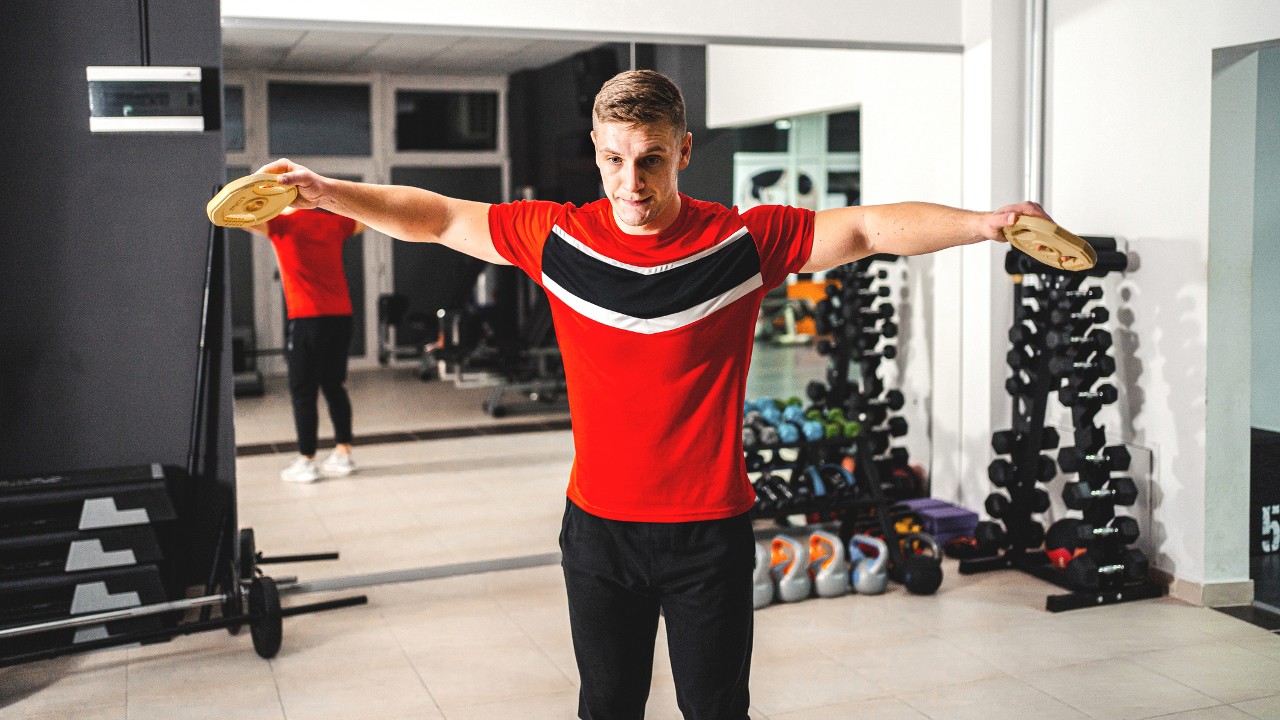
The lateral raise is one of the best shoulder exercises for those looking to build muscle in their shoulders. It’s also a very simple movement: essentially you just raise weights to the sides and up to shoulder level, then lower them again—though naturally we have some far more detailed advice about perfect form to follow.
However, don’t let that simplicity fool you into thinking you’re in for an easy time. The lateral raise is devilishly hard, even with very light weights. What seems incredibly simple on rep one is absolute murder by rep eight, so pick your weight wisely. If you’re doing this exercise for the first time, choose the weight you think will allow you to complete all the reps with good form—then go lighter. One set shouldn’t take much more than a minute—so why risk an injury for the sake of 12 reps with weights that are too light?
Read on for our comprehensive guide to how to do the lateral raise, including the basics, expert form tips and a couple of variations to try that will round out your shoulder session.
Which muscles does the lateral raise work?
The lateral raise is one of the best exercises to build strength and definition in the lateral (middle) deltoids, small triangular muscles located on top and side of the shoulder. They are primarily responsible for raising the arms to the sides, stabilizing the shoulder joint and shielding it from strain while carrying heavy loads. Targeting your lateral deltoids will also make your frame look a lot bigger and give your shoulders that rounded look, as CrossFit Games athletic James Sprague told Coach.
The lateral raise also works other shoulder muscles, such as the front deltoid. A 2020 study published in the Journal Of Human Kinetics compared maximum isometric voluntary contraction (or muscle activity) in the shoulder muscles for the bench press, dumbbell flye, shoulder press and lateral raise exercises, and found that the lateral raises came on top almost every time. Thirteen male study participants completed 12 reps of each exercise using 60% of their one-rep max, and only the shoulder press created notably higher front delt engagement than the lateral raise. However, the lateral raise presented significantly higher activity in the middle delts than both the bench press and dumbbell flye, and almost as much as the shoulder press, and also came out on top for rear delt activation, which all adds up to a great exercise for developing well-balanced shoulders.
The lateral raise is not just about the shoulders, though. Other muscles engaged include the tiny muscles responsible for extending and flexing the wrists, as well as the trapezius muscle, a large muscle that covers most of your upper and mid-back. Standing lateral raises will also work your glute and core muscles, because they are recruited to keep you upright and stop you from swaying.
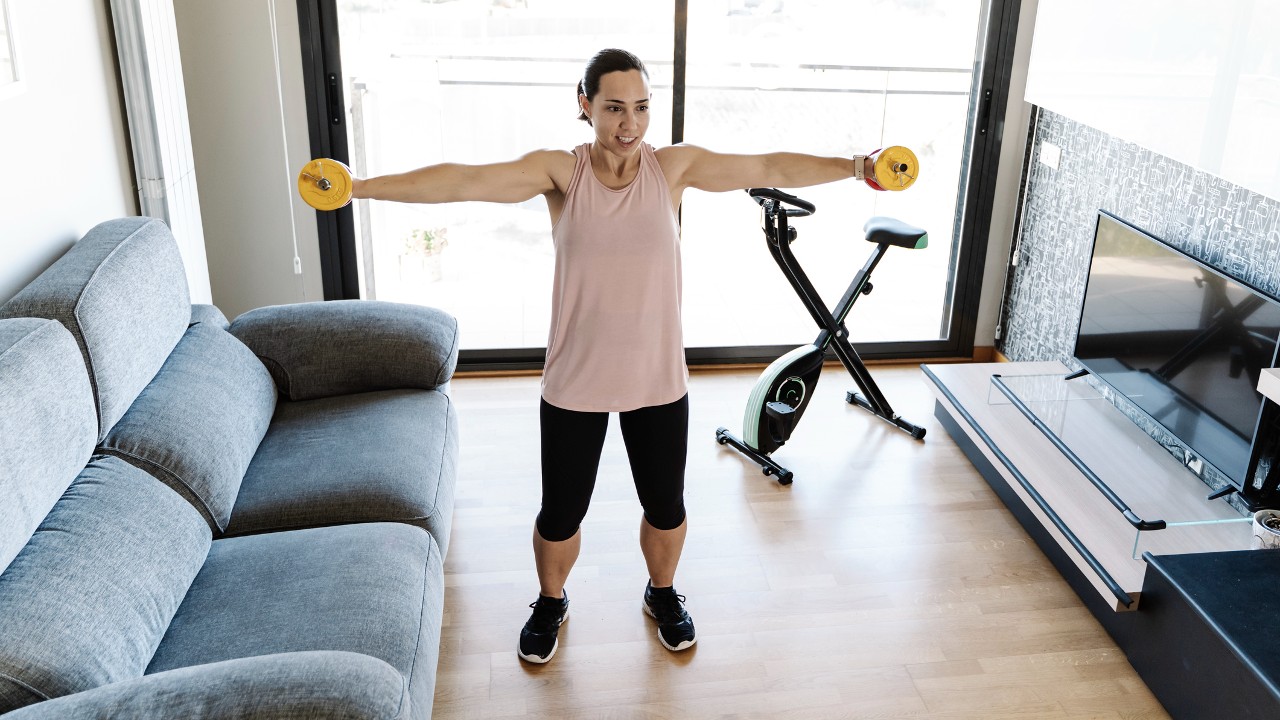
Lateral Raise Benefits
The lateral raise can help you build bigger, stronger shoulders, which should be enough to prompt most to reach for the nearest dumbbells—but the benefits don’t end there. The plus points of the lateral raise extend to increased shoulder mobility, stability and health too.
Since the shoulder joint is the least stable and most mobile in the body, it’s vulnerable to injury and dislocation. “The lateral shoulder raise is a great way to ensure good shoulder health, because it helps maintain good range of motion in all directions,” says Noelle McKenzie, a certified personal trainer at Leading Edge Personal Trainers in New York City. “If we only train the shoulder one dimensionally, we’re putting ourselves at risk of hurting ourselves, not only during exercise but also during everyday life.”
The lateral raise can also help improve performance in compound exercises, such as the overhead press and the barbell bench press. And because you’ll need only a fairly light weight for the lateral raise, it’s well suited to exercising at home where you may only have a light pair of dumbbells or a resistance band.
How To Do The Lateral Raise
Selecting the correct weight is key to doing lateral raises safely. You’ll find that even with light weights, the last few raises are a real challenge, so there’s no need to grab the heaviest dumbbell. “Trying to lift too heavy is probably the biggest challenge is maintaining good control. Focus on working on form and technique first, rather than increasing load,” says McKenzie.
Sign up for workout ideas, training advice, reviews of the latest gear and more.
Stand or sit with a dumbbell in each hand at your sides. Keep your back straight, brace your core, and then slowly lift the weights out to the sides until your arms are parallel with the floor. Lower the dumbbells slowly and keep them under control. Don’t go beyond horizontal when you’re raising the weights, and ensure you keep your arms out to your sides. If they start creeping forward it’s time to opt for a lighter weight.
A lot of people will cheat by “shrugging” the weights up using their traps. Resist the urge to do that by not raising your shoulder blades during the rep and focusing instead on the delts. “The crucial part of the lateral raise is to control the weight well on both the concentric [lifting the weight] and eccentric [lowering the weight] portion of the movement,” says Sprague.
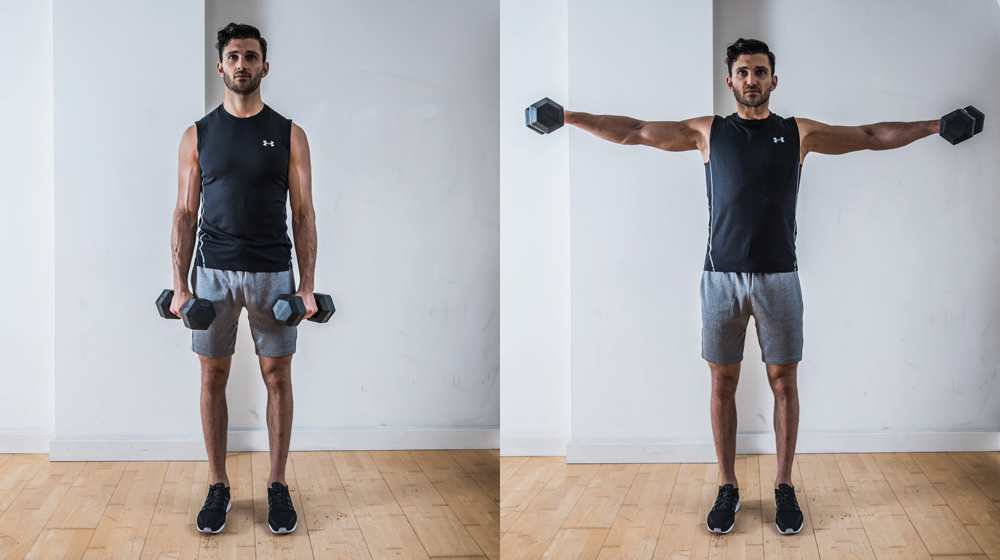
Lateral Raise Form Tips
1. Don’t use momentum
What “The most common error when performing lateral raises is using your momentum to lift the weight up by swinging the dumbbell,” says Sprague. This is often caused by picking weights that are too heavy.
Why “When you rely on momentum, it can result in you using less of the lateral head of the delt and using your traps instead,” says Sprague. “This is a common fault with a lot of upper-body movements, which can lead to the traps becoming overdeveloped.” Throwing the weights up and down also reduces the control over the weight, which increases the chances of injury or strain.
How If you can’t lift weights without relying on momentum, select a lighter weight, then focus on your form and pacing. You want the movement to be slow and controlled.
2. Lead with your elbows
What Raise the dumbbells leading with your elbows, so that they’re the highest part of your arm.
Why Ensuring your elbows lead the move will keep the focus on your delts and minimize the stress placed on your rotator cuffs, a small group of delicate but crucial stabilizing muscles.
How Raise your elbows out to the sides, maintaining a slight bend in the joint. Concentrate on how your side delts feel and contract as the weights are raised.
3. Turn your wrists
What As your hands approach shoulder height, rotate your wrist so that your little fingers are uppermost.
Why Turning your wrists as the dumbbells reach the top of the move activates more muscle fibers in your side delts, meaning each rep works the muscle even harder. “But if you turn your palm so that your thumb faces up, it’s going to hit more of the anterior (front) part of the shoulder,” says McKenzie.
How Once your elbows are at shoulder height, turn your wrists as if you were pouring two jugs of water so your little fingers are the highest parts of your hands. Reverse this movement as you lower the weights again. “Make sure not to grip the dumbbell too tightly as this will prevent the recruitment of your forearm muscles,” says Sprague.
4. Go down slower
What From the top of the move, lower the weights back to the start as slowly as possible.
Why Taking your time to lower the dumbbells forces your shoulders to work harder to manage the weight, so you recruit more muscle fibers in order to maintain control. The more muscular damage you do, the greater your growth return. “Manipulating the time under tension helps increase the intensity without increasing the load,” says Kern Alexander, a certified personal trainer at Leading Edge Personal Trainers.
How Aim for a two-second lowering phase at first, then increase it over time.
5. Raise and stop
What Make a strategic stop just before the top of the move.
Why Adding a pause is great for muscle enhancement. “It’s a way of stopping momentum and increasing the time that you’re spending under the force of gravity pulling directly against the muscle fibers,” says Alexander.
How Before a set of lateral raises, hold the weights just below shoulder height for 10 seconds, then do 10 reps. Repeat three times.
Lateral Raise Variations
Front raise

Why If you get bored with lateral raises (as if that could ever happen) then you can mix things up with front raises. These involve exactly the same movement, but with your arms straight out in front of you, shifting the focus to the anterior or front deltoid.
How Hold dumbbells in front of your thighs with palms facing you. Lift to shoulder level. Lower under control.
“Both of these exercises are equally difficult, but you might be a little stronger doing a front raise,” says Alexander. “That’s because the front delts get a lot of work when you press, and most of us do a lot of pressing movements. So those muscles are usually more developed than the mid delts.”
Resistance band lateral raise
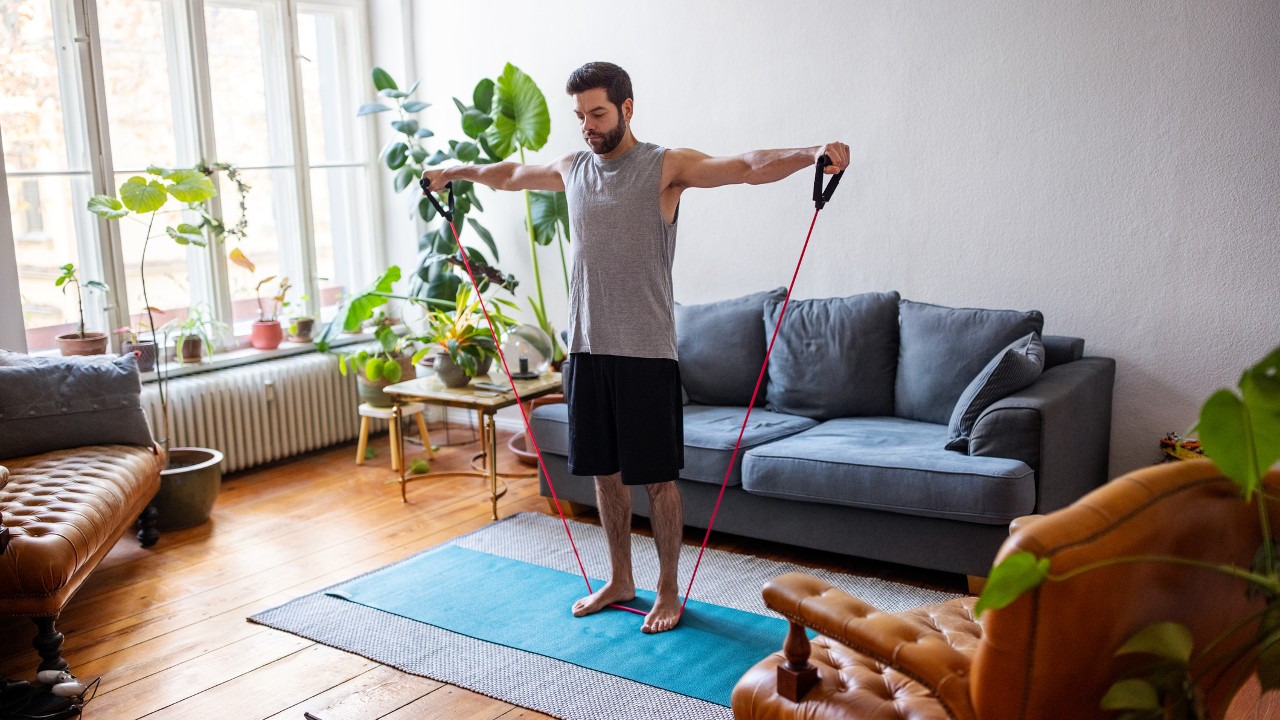
Why The lateral raise is a great exercise to use resistance bands for, because you don’t need much weight to get great results and the bands will provide more of a challenge at the top of the lift. It’s also a gentler option on your joints if you’re worried about any shoulder niggles and, of course, using portable bands means you can get a spot of lateral raising whenever the mood takes you. “A resistance band allows you to maintain resistance throughout the entire range of motion, and you can always adjust the intensity of the band because different bands have different levels of resistance,” says McKenzie.
How Stand on the middle of the band holding one end in each hand, then raise your arms out to the sides until they are parallel to the ground. Lower slowly, working against the pull of the band.
Reverse flye

Why Also known as the reverse or bent-over flye, this variation puts more focus on your posterior (or rear) deltoids and the muscles in your upper back because of the change in the angle.
How Stand with dumbbells by your sides. Hinge at the hips and bend over until your torso is parallel to the floor, or close to that point, keeping your back straight. Let the dumbbells hang down beneath your chest. Raise the weights out to the sides until your arms are parallel with the ground, then slowly take them back down.
Make sure you don’t rock your body or move any other part of it to create momentum. If you’re struggling to stay still, try the bent-over lateral raise while lying on a bench.
Lateral Raise Workouts
Now you’re au fait with the lateral raise you need some workouts to use it in, and you’ll find these below. Just remember when doing dumbbell workouts that you might need lighter weights for the lateral raise than other exercises.
Shoulder workout routine for size: This challenging shoulder session involves doing rounds of exercises with little to no rest. The first round involves three heavy barbell lifts and the second a trio of dumbbell exercises, including the seated lateral raise.
Superset shoulder workout: This taxing shoulder session starts with a couple of big compound lifts before moving into supersets using lighter weights to work your shoulders from a variety of angles. You’ll need dumbbells, a barbell and weight plates, and access to a cable machine for the workout, so it’s best done in a gym.
Home shoulder workout: If you’d rather build the lateral raise into a home workout, this session just requires one set of light dumbbells. The workout is made up of three sets of the 30/30 push press, followed by a tri-set of shoulder exercises including the lateral raise.
Dumbbell shoulder workout: You can use this short dumbbell workout as a standalone shoulder session or add it to the end of a bigger workout as a challenging finisher. It involves three rounds of three shoulder moves done without any rest, with the lateral raise featuring alongside the reverse flye and Arnold press.
About Our Experts

Kern Alexander is an ACE-certified personal trainer and a NASM-certified corrective exercise specialist. With his wife Noelle McKenzie, he co-founded Leading Edge, an in-home personal training business based in New York City. He specializes in weight management, strength training, bodybuilding and treating a range of musculoskeletal conditions, including sciatica and back pain.
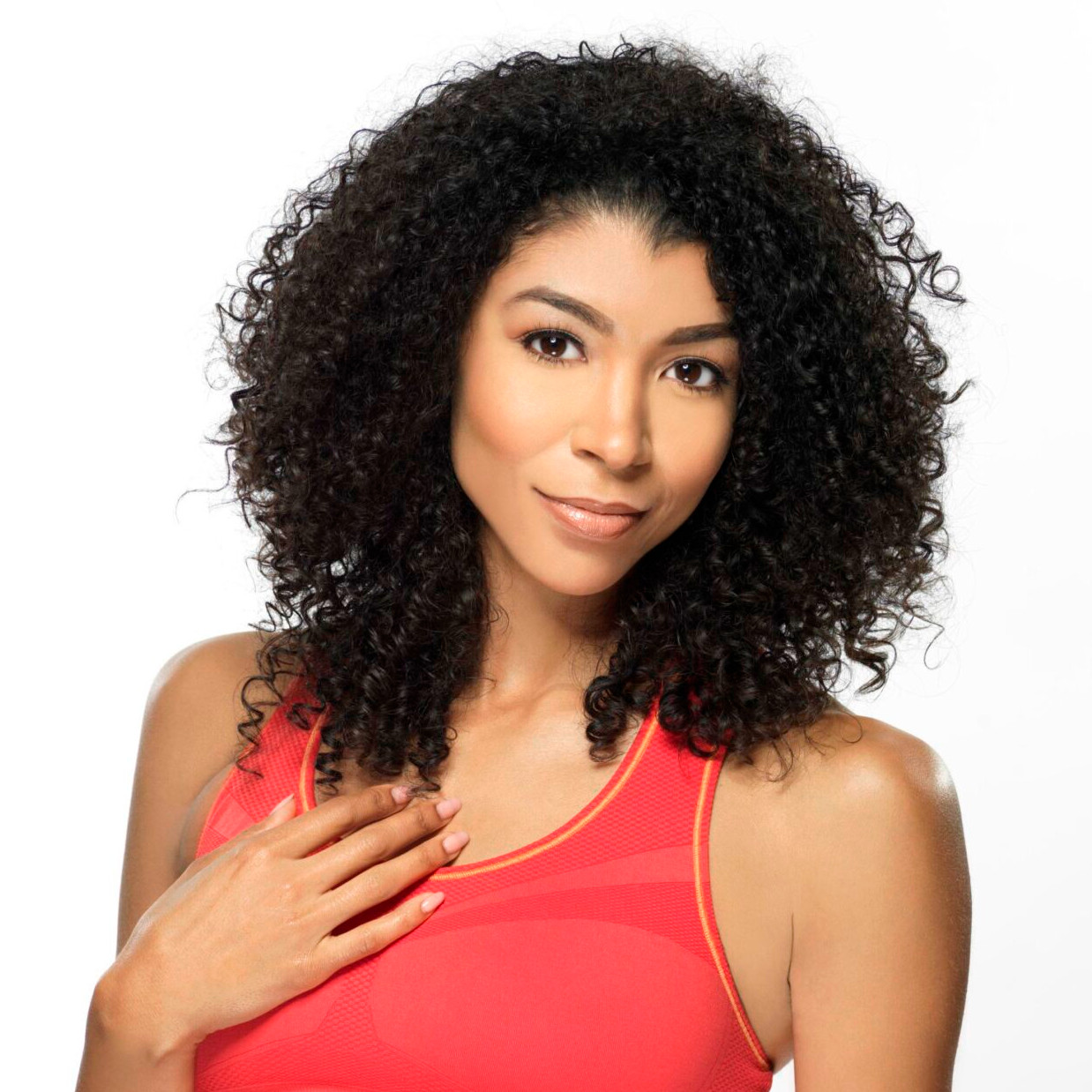
Noelle McKenzie is an ACE-certified personal trainer, functional training specialist and level 1 Kettlebell Kings training expert. With her husband Kern Alexander, she co-founded Leading Edge, an in-home personal training business based in New York City. Her training style is centered around yoga, kettlebell training and improving functional movement patterns.

James Sprague is a CrossFit Games athlete from Snoqualmie, Washington. He began competing in 2017, finishing fourth in the Boys 14-15 division, and he’s been rising up the rankings ever since. Currently, he holds 33rd place in the CrossFit Games World Wide Ranking, and has relocated to Naples, Florida, to train under Matt Torres, head coach of Brute Strength HQ. James is also a NASM-certified personal trainer, offering fitness coaching services through his company Next Gen Performance.
From 2008 to 2018, Joel worked for Men's Fitness, which predated, and then shared a website with, Coach. Though he spent years running the hills of Bath, he’s since ditched his trainers for a succession of Converse high-tops, since they’re better suited to his love of pulling vans, lifting cars, and hefting logs in a succession of strongman competitions.
- Harry BullmoreStaff writer
- Nick Harris-FrySenior writer
- Anna GoraHealth writer

